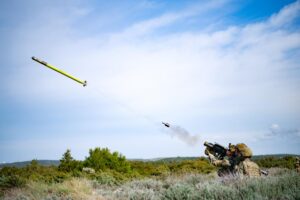HUNTSVILLE, Ala. – The Army has selected Lockheed Martin [LMT] and
Raytheon Technologies [RTX] to work on prototyping capabilities for a future Stinger missile replacement over the next few years, a lead official confirmed Tuesday.
Brig. Gen. Frank Lozano, the Army’s program executive officer for missiles and space, said negotiations with the vendors on Other Transaction Authority (OTA) agreements are currently ongoing for the program officially called “Maneuver Short Range Air Defense Inc. 3.”

“We’re working with the two selected vendors right now to refine the statement of work,” Lozano said at the Association of the United States Army’s Global Force Symposium here. “And we’re going to work with those two vendors to carry them through a competitive rapid prototyping effort over the next four and a half years.”
The Army last March released a Request for Information for its effort to find a replacement for Stinger missiles, currently built by Raytheon, detailing a goal to start production of 10,000 new missile systems in FY ‘27 (Defense Daily, April 11 2022).
Officials then released a call for enhanced white papers from industry to detail their solutions, before potentially selecting capabilities for development.
Army officials in the RFI detailed the need for a replacement system “to meet increasing demand and growing threat capability,” noting the Stinger-Reprogrammable Microprocessor will become obsolete in FY ‘23 and that the “current Stinger inventory is in decline.”
Steven Botwinik, Lockheed Martin Missiles and Fire Control’s vice president of advanced programs execution, confirmed the company’s selection for the prototyping effort in an interview with Defense Daily on Tuesday.
“It’s basically to go through prototyping and then there’s a whole bunch of options, as you’d expect, beyond that to continue,” Botwinik said. “Because it’s an OTA, it’s an invitation to negotiate with the government. So we’re in the negotiation phase right now.”
Doug Bush, the Army’s top acquisition official, said last July the Army was confident in moving toward a Stinger missile replacement competition after the RFI yielded a “lot of really good responses with high-technology readiness levels” (Defense Daily, July 27).
Boeing [BA] previously told Defense Daily in October it planned to respond with a white paper proposing a solution it said would offer up to three times the lethality capability of the current surface-to-air weapon system (Defense Daily, Oct. 11).